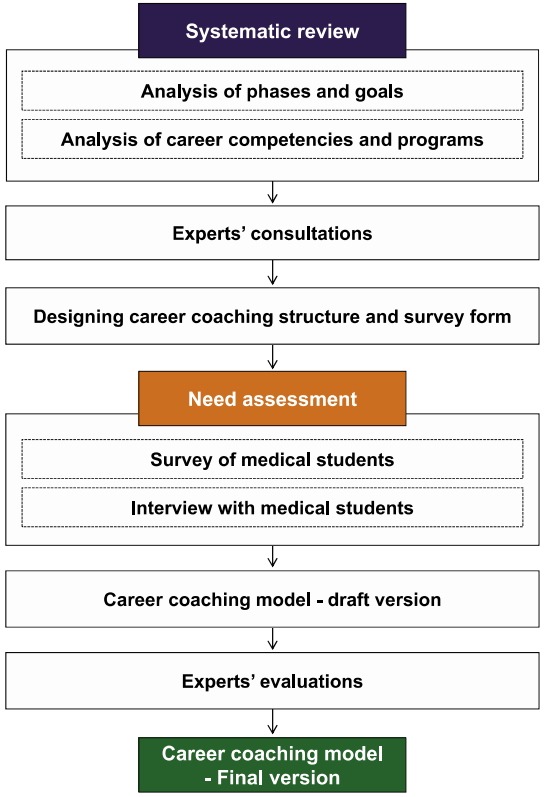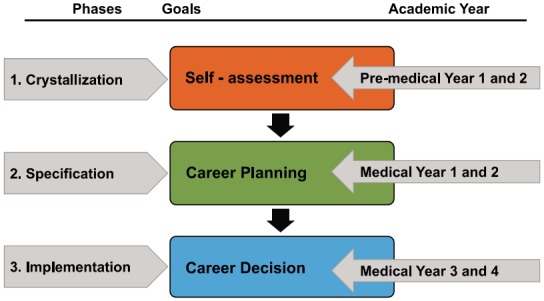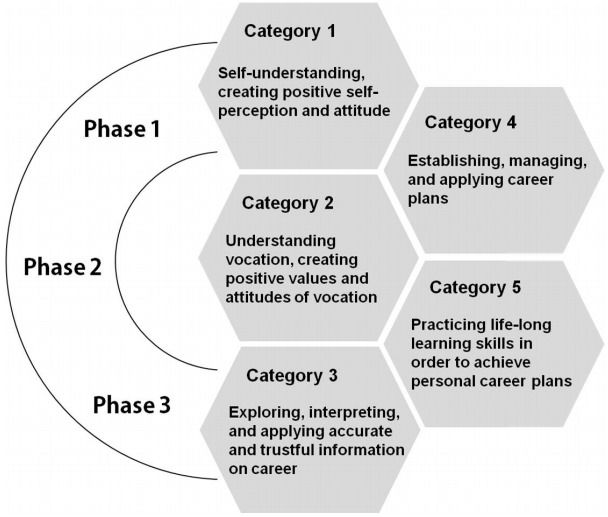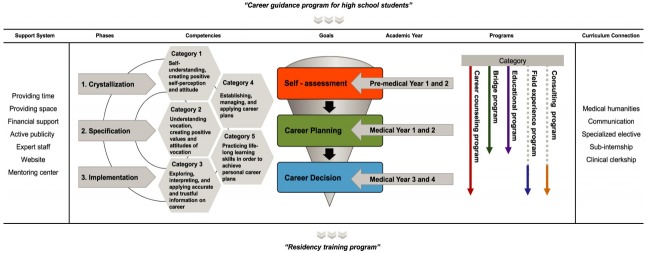Abstract
Purpose:
Deciding on a future career path or choosing a career specialty is an important academic decision for medical students. The purpose of this study is to develop a career coaching model for medical students.
Methods:
This research was carried out in three steps. The first step was systematic review of previous studies. The second step was a need assessment of medical students. The third step was a career coaching model using the results acquired from the researched literature and the survey.
Results:
The career coaching stages were defined as three big phases: The career coaching stages were defined as the “crystallization” period (Pre-medical year 1 and 2), “specification” period (medical year 1 and 2), and “implementation” period (medical year 3 and 4).
Conclusion:
The career coaching model for medical students can be used in programming career coaching contents and also in identifying the outcomes of career coaching programs at an institutional level.
Keywords: Career coaching, Medical students, Mentoring, Counseling, Professionalism
Introduction
Medical students are apt to think that their career path has been determined at the time of their admission into medical school. In reality, excessive admission and competition among students do not allow sufficient time for career exploration and, as a result, there is a likelihood that students may have chosen to study medicine because of their academic grades or influence by their parents. From a previous study involving 655 students with a high level of academic excellence, students from the engineering, science, and medical departments answered that the most essential factor in deciding their career path is aptitude. However, students who wish to major in medicine are more influenced by their employment outlooks, socioeconomic status, parents’ recommendations, and academic scores than students in engineering and science [1]. Another study reported that a medical student’s enrollment factor is heavily related to academic grades, job stability, and a guaranteed future [2]. When a student’s aptitude is not given sufficient consideration, this can cause some concerns over adjustments to campus life and have a significant impact on their future life as a doctor [2,3].
Current medical education is focused on making good doctors who are professional and have gained adequate medical knowledge and skills [4], and has given little attention to the guidance of a medical student’s career choices. Whether they have given their chosen careers serious thought or not, what kind of support can be provided through medical education? Even the postmodern paradigm of professionalism is focused on balancing the life of one person, which is important to all medical students [5]. Such balance means improving the quality of their work life, and to do this, it is necessary to take the first step towards choosing the right career path. In reality, the lack of attention is evidenced by the lack of research on the subject.
Using the PubMed search engine with keywords such as “career guidance” or “career coaching” and “medical students,” we found only 11 papers between 1986 and May 2015 that include these keywords in their title or abstracts, including Scherger & Swisher’s study [6]. There are papers that research the satisfaction rates of the mentoring [7] and formal faculty advisors’ programs [8] that were organized within the existing curriculum. These papers, despite their importance and contribution to the research field, focus mainly on the satisfaction rate of the programs. They only briefly discuss the students’ level of perception about the subject [9] or the kind of counseling needed for medical students by analyzing vocation interest types [10,11] or need assessment on career guidance programs [12], all of which are limited subjects. This does not give sufficient information to develop a systematic career coaching program.
The current study goes beyond the previous research by identifying the concept, purpose, and steps of career coaching needed for medical students and develops a systematic model for career mentoring theme. Specific research objectives of the study are as follows: (1) examine the career coaching structure through literature study; (2) develop a career coaching map; (3) identify the need for career coaching among medical students; (4) develop a career coaching model specific to those students.
Subjects and methods
1. Procedures
This research was carried out in three steps (Fig. 1). The first step was a systematic review of previous studies. The second step was a need assessment. The survey consisted of two questions considering program and support of the career coaching. Students were asked to answer the priorities of career coaching program needs by academic levels. And also to specifically state the kind of support system they needed. The total number of students on participants was 633 from five medical schools in Korea from 2014. But 629 replies were finally selected for analysis after the surveys because of the missing values. And, focus group interviews (FGI) were conducted with two students to seek and combine their opinions in revising the results of the need assessment (Table 1). Finally, our third step was to develop a career coaching model based on the results acquired from the researched literature and the need assessment. And four specialists from the field of medical education and career coaching evaluated the model for its suitability (Table 2, Appendix 1).
Fig. 1.

Research Procedure
Table 1.
Subject of Need Assessment
| Group | Gender | Pre-medical year |
Medical year |
Total | |||
|---|---|---|---|---|---|---|---|
| 1st | 2nd | 1st | 2nd | 3rd | |||
| Survey | Male | 101 | 106 | 124 | 79 | 40 | 450 |
| Female | 40 | 50 | 54 | 24 | 11 | 179 | |
| Interview | Male | - | - | 1 | - | - | 1 |
| Female | 1 | - | - | - | - | 1 | |
| Total | 142 | 156 | 179 | 103 | 51 | 630 | |
Data are presented as number.
Table 2.
Subject of Focus Group Interview
| Position | Gender | Affiliation | |
|---|---|---|---|
| Experts | Faculty | Male | Medical college, Medical education |
| Faculty | Female | Medical school, Medical education | |
| Faculty | Female | Medical school, Medical education | |
| Coaching Expert | Female | Today & tomorrow human resource development center |
2. Statistical analysis
The quantitative data collected for the purposes of this study was analyzed by SPSS version 21.0 program (IBM Corp., Armonk, USA) and verified within the p-value of 0.05. First, the survey results of the students’ needs were ranked based on the frequency analysis. Second, the information from FGI was evaluated by carrying out descriptive statistics mean and standard deviation analysis, including a Intraclass Correlation Coefficient (ICC) (two-way random model).
3. Ethics approval
This study was approved by the Institutional Review Board of Konyang University College of Medicine (IRB number: KYUH 2014-03-014-003).
Results
1. Career coaching structure
1) Phases
Scholars approach the subject of career development differently. Ginzberg et al. [13], for example, explain that personal career development, which begins from childhood, is completed in the early days of adulthood. Super [14,15,16,17] argues against Ginzberg’s idea of career development theory that a career is a series of compromises, making choices, and adapting processes across a person’s life span. We chose the Super theory, which emphasize that career coaching should allow the students to develop their career continuously throughout their lives. According to Super’s career lifespan, college students fall into the category of Specification (ages 18 to 21) and Implementation (ages 22 to 24) substages from the Exploration stage (ages 15 to 24). There were two reasons why we included the crystallization substage (ages 15 to 17) in the career coaching structure. First, medical students nowadays choose move into various categories of vocations. For example, some choose to become lawyers or reporters specialized in medicine, and health care field is expanding its diversity. Second, although students chose to enter medical school, they might not have thoroughly examined themselves enough for their values, interests, and needs of their prospective career [18] or specific majors they would like to choose afterwards. Thus the phases of career coaching were finally named as crystallization, specification, and implementation.
2) Goals
In Super’s theory, goals were presented in accordance with the career development stages. The first stage, crystallization, emphasizes self-assessment of one’s need, values, competencies, and opportunities. The second stage, specification, is about establishing preferences of specific vocation and designing the career. The third stage, implementation, is where training for the specific choices and other efforts are done in order to establish the career goal.
But most Korean medical schools run a 2+4 year educational system, consisting of 2 years of premedical and 4 years of medical coursework. Medical students start their clinical years from year 3, so their decision on specific major will be after this period. Therefore the “Implementing” stage was staged at the third phase where students’ career decision is made. At each three phases, goals were set and the representative words for these goals were named as “self-assessment,” “career planning,” and “career decision,” respectively (Fig. 2).
Fig. 2.

Career Coaching Structure
3) Targets
The targeted academic year in accordance with three phases of career coaching were decided by the experts’ consultation. From the consultation process, the 2+4 system characteristics of medical education were taken into account. The first 2 years are generally Pre-medical year, and the next 2 years curriculum mainly consist of basic and clinical medicine including introduction to clinical medicine, and the last 2 years are mainly the clerkships including specialized and advanced courses. Therefore, the targeted academic year of each career coaching phases were decided as Pre-medical year 1 and 2 for crystallization, medical year 1 and 2 for specification, and medical year 3 and 4 for implementation. The structure of career coaching was finalized as Fig. 2.
2. Career coaching map
1) Competencies
The Korea Research Institute for Vocational Education and Training (KRIVET) report suggests five categories of career training strategies [19] which are already used in Korean formal education system. These five categories were taken into account in deciding the career competencies in career coaching. But these five categories were not classified into separate phases but positioned circularly to emphasize these competencies to be acquired in a systematic and integrated method (Fig. 3).
Fig. 3.

Career Competencies Map
2) Program category
In order to extract the specific program themes for career coaching, we retrieved papers using the PubMed and RISS engines that used “career guidance program” and “career development program” as keywords, in titles, or in abstracts. The results were then sorted into papers that used college students as their target subject. For the final review, three papers were chosen in order to identify the domains of the career coaching program. The identified domains were self-assessment, psychological tests, career counseling, school adaptation counseling, providing career information, career seminars, faculty and senior career mentoring, career interest groups, study groups, basic skills enhancement workshops, internships, field trips, volunteer services, interviewing/resumes/personal statements correction, residency match process, student performance evaluation (or dean’s Letter), changing majors/transfer/study abroad information, part time/job information, and so on [12,20,21]. From the results, key subjects of the program to be included in the career coaching model were first reviewed by experts’ consultations and then their categories were specifically itemized after thorough evaluation (Fig. 4).
Fig. 4.

Career Coaching Program Map
3. Needs assessment on career coaching
Students were asked to select suitable career coaching programs according to academic years. The results were as follows (Table 3). From the survey items asking about the support system required for the career coaching program, students’ needs were high for systematic support of time, money, and space. Next came the need for various career coaching programs implemented in the curriculum, placement of coaching expert, and active promotion of career coaching programs. Other opinions such as building mentoring center and online website of career coaching were given.
Table 3.
Career Coaching Programs Requested according to Academic Years
| Category | Pre-medical |
Medical |
|||||
|---|---|---|---|---|---|---|---|
| 1st | 2nd | 1st | 2nd | 3rd | 4th | ||
| Counseling program | 23.5 | 22.3 | 22.3 | 19.4 | 16.9 | 11.8 | |
| Bridge program Ia) | 24.0 | 24.1 | 22.7 | 20.8 | 12.8 | 13.9 | |
| Bridge program IIb) | 20.5 | 20.3 | 20.7 | 21.2 | 21.2 | 18.5 | |
| Educational program | 19.9 | 18.7 | 16.1 | 14.2 | 11.4 | 11.9 | |
| Field experience program | 10.9 | 12.5 | 15.7 | 20.3 | 26.3 | 23.2 | |
| Consulting program | 1.2 | 2.1 | 2.4 | 4.1 | 11.4 | 20.8 | |
Data are presented as percentage.
Bridge program I: meeting with various career field experts,
Bridge program II: mentoring with main interesting career field experts.
4. Career coaching model for medical students
We combined the career coaching structure which was primarily determined, with the career coaching maps in order to develop the basic model of career coaching. The students’ needs were taken into account as much as possible when the program categories were allocated by academic years. Experts’ consultation was done to finalize the model. During the expert consultation the following matters were dealt with: (1) configuration and the possibility of linking the career coaching program with the formal education process, and (2) possible time allocation of the program in the existing curriculum. In particular, in this basic model we emphasized the continuity and intensification of the career coaching throughout the medical education curriculum like a spiral model. Finally, we added the support system and curriculum connection identified by FGI to the basic model and developed the final version (Fig. 5).
Fig. 5.
Career Coaching Model: Final Version
The final career coaching model was established through the assessment of the experts. From FGI, the model assessment was analyzed for its suitability and, from the evaluation, the average mean was 4.25 (out of 5.00) with a standard deviation 0.38 (Table 4). The model can thus be interpreted as being valid and therefore finalized. Finally, we used the ICC to verify the degree of concurrence between the evaluators. The result was that the average measures of ICC were 0.900 which meant the reliability of FGI scores were verified (p=0.001).
Table 4.
The Results of the Suitability Assessment of the Career Coaching Model
| Assessment area | Expert group |
Mean | |||
|---|---|---|---|---|---|
| Expert A | Expert B | Expert C | Expert D | ||
| Adequacy | 5.0 | 5.0 | 4.0 | 4.5 | 4.63 (0.50) |
| Linkage | 4.0 | 4.0 | 3.0 | 3.7 | 3.67 (0.89) |
| Applicability | 4.5 | 4.5 | 4.5 | 4.0 | 4.38 (0.52) |
Data are presented as mean (standard deviation).
Discussion
Students who attend medical school are said to be excellent students, but most students in Korea still choose to become clinicians. Recently, medical education has tried to provide opportunities that ensure medical students are given sufficient navigation throughout their career exploration and allow them to become settled in various professional specialties of their own interest [10]. From many previous studies, career counseling and career guidance programs have positive effects, ranging from making career decisions to fewer dropout rates, and especially in specialty choices [21,22,23]. This study has developed a career coaching model for medical students from that background. This model offered three big phases of career coaching, with each stage having clear goals, competencies based on the student’s academic level. In addition, it has suggested program categories with support systems linked to the medical education curriculum. The results of the study can be used in the following aspects.
First, the 6-year model in three phases implies that career coaching should be a spiral program, beginning with the student’s entry and continuing until graduation. Specifically, the career coaching should be a stepped process according to the development tasks of each stage. The content itself should also be a spiral process, and whenever the student’s specific career is decided, an appropriate level of training or experience should follow. In addition, a series of career coaching sessions would also help the students to clarify their wants, needs, and their career values so that even after graduation, they can respond with flexibility to the changes required of them. The Organisation for Economic Co-operation and Development (OECD) reported that career coaching is not simply a readiness program, but should provide a comprehensive approach, including the medical education period, and assist college freshmen to adjust to higher education [24].
Second, the career coaching model should be specific to the academic year in order to achieve each phase’s goal. From the need assessment, differences were found in the desired programs according to the student’s academic level. Specifically, students in lower academic levels wanted interaction with personnel from various medical health professions and in-depth career counseling hours. Students in the higher academic levels, however, desired to meet personnel from specific career choices, field experiences, and in-depth consulting hours for career decisions. The need for tailoring career coaching programs according to academic levels was also discussed by An et al. [12].
Thirdly, the career coaching model not only links to the support system and the medical education curriculum, but it should also be supported by the institution with regards to time, location, and financial support. Without any dramatic changes to the existing curriculum, and only a minor modification to content and method, the program can be connected and integrated with curriculum courses. This will enhance the likely implementation of the model.
There are some limitations of the study, and subsequent research proposals are as follows. First, literature research and needs assessment, including the expert group meeting, was carried out to develop the model and tried to secure the feasibility of the research; however, the subject under research did not include a sufficient number of medical school students (year 4 system, graduate school level). Therefore, further research of the need assessment undertaken by graduate school level medical students is required in order to boost the feasibility of the study, and identify if any modifications to the model are necessary. Secondly, the category of the career coaching program was proposed, but no specific description of the content has yet been made. This is because it is necessary for the institution itself to develop specific content in the context of its educational environment and the medical education curriculum. However, follow-up studies may be able to deal with some examples of specific program content and instructional methods of the program.
In conclusion, the model developed in this study is most significant in helping to set the direction of career coaching by suggesting the phases, goals, competencies, and the program categories. The career coaching model can be utilized as a guideline in the establishment of career coaching outcomes and when developing its content at an institutional level.
Acknowledgments
I would like to thank professors Sun Kim and Sun Huh for their valuable discussions and sharing their experties. I would also like to show my deepest gratitude to A Ra Cho for her unremitting hard work and input.
Appendix 1.
Footnotes
Funding
This work was supported by the National Research Foundation of Korea Grant funded by the Korean Government (NRF-2014S1A5A2A01013740).
References
- 1.Kim EK. Factors influencing the choice of major for high achievement students in high school. J Eng Educ Res. 2010;13:80–86. [Google Scholar]
- 2.Pagnin D, De Queiroz V, De Oliveira Filho MA, Gonzalez NV, Salgado AE, Cordeiro e Oliveira B, Lodi CS, Melo RM. Burnout and career choice motivation in medical students. Med Teach. 2013;35:388–394. doi: 10.3109/0142159X.2013.769673. [DOI] [PubMed] [Google Scholar]
- 3.Kim JY, Son HJ, Kim TJ, Choi YH, Kim HJ, Kee CW, Kim JH, Hong KP. The impact of application motives on medical school adjustment. Korean J Med Educ. 2004;16:207–218. [Google Scholar]
- 4.Hur Y. Are there gaps between medical students and professors in the perception of students' professionalism level? Secondary publication. Yonsei Med J. 2009;50:751–756. doi: 10.3349/ymj.2009.50.6.751. [DOI] [PMC free article] [PubMed] [Google Scholar]
- 5.Beauchamp G. The challenge of teaching professionalism. Ann Acad Med Singapore. 2004;33:697–705. [PubMed] [Google Scholar]
- 6.Scherger JE, Swisher ML. Career guidance for medical students with an interest in family practice. Fam Med. 1986;18:73–77. [PubMed] [Google Scholar]
- 7.Ramanan RA, Taylor WC, Davis RB, Phillips RS. Mentoring matters: mentoring and career preparation in internal medicine residency training. J Gen Intern Med. 2006;21:340–345. doi: 10.1111/j.1525-1497.2006.00346.x. [DOI] [PMC free article] [PubMed] [Google Scholar]
- 8.Myhre DL, Sherlock K, Williamson T, Pedersen JS. Effect of the discipline of formal faculty advisors on medical student experience and career interest. Can Fam Physician. 2014;60:e607–e612. [PMC free article] [PubMed] [Google Scholar]
- 9.Dambisya Y. Career intentions of UNITRA medical students and their perceptions about the future. Educ Health (Abingdon) 2003;16:286–297. doi: 10.1080/13576280310001607442. [DOI] [PubMed] [Google Scholar]
- 10.Hur Y, Cho AR, Kim S. How to provide tailored career coaching for medical students. Korean J Med Educ. 2015;27:45–50. doi: 10.3946/kjme.2015.27.1.45. [DOI] [PMC free article] [PubMed] [Google Scholar]
- 11.Hur Y, Lee K. Vocational interest types of medical students and its usage in student career counseling program. Korean J Med Educ. 2012;24:309–317. doi: 10.3946/kjme.2012.24.4.309. [DOI] [PMC free article] [PubMed] [Google Scholar]
- 12.An H, Kim E, Hwang J, Lee S. Analysis of medical students' needs for development of a career guidance program. Korean J Med Educ. 2014;26:209–216. doi: 10.3946/kjme.2014.26.3.209. [DOI] [PMC free article] [PubMed] [Google Scholar]
- 13.Ginzberg E, Ginsburg S, Axelrad S, Herma J. Occupational choice: an approach to a general theory. New York, USA: Columbia University Press; 1951. [Google Scholar]
- 14.Super DE. A theory of vocational development. Am Psychol. 1953;8:185–190. [Google Scholar]
- 15.Super DE. A life-span, life-space approach to career development. J Vocat Behav. 1980;16:282–298. [Google Scholar]
- 16.Lau PL, Low SF, Zakaria AR. Gender and work: assessment and application of Super’s theory: career maturity. Psychol Behav Sci. 2013;2:36–42. [Google Scholar]
- 17.American Counseling Association . The ACA encyclopedia of counseling. New York, USA: John Wiley & Sons; 2015. [Google Scholar]
- 18.Kim KS, Lee HC. The effect of career education on career maturity of adolescents in South Korea: focusing on the analysis KEEP and KYPS. Second Educ Res. 2012;60:1079–1103. [Google Scholar]
- 19.Lee JY, Lee YD, Jung YK, Choi DS, Kim NR, Jang SM, Jung YG, Nam MS, Lee KN. Establishment of an operation model for integrated career education (II) Seoul, Korea: Korea Research Institute for Vocational Education and Training; 2009. [Google Scholar]
- 20.Lee YJ. A study on improvements in career guidance service system at college level in Korea through demand survey. Korea J Counsel. 2004;5:1095–1110. [Google Scholar]
- 21.Zink BJ, Hammoud MM, Middleton E, Moroney D, Schigelone A. A comprehensive medical student career development program improves medical student satisfaction with career planning. Teach Learn Med. 2007;19:55–60. doi: 10.1080/10401330709336624. [DOI] [PubMed] [Google Scholar]
- 22.Folsom B, Reardon R. College career courses: design and accountability. J Career Assess. 2003;11:421–450. [Google Scholar]
- 23.Harris JA, McKay DW. Evaluation of medical career-counseling resources across Canada. Teach Learn Med. 2012;24:29–35. doi: 10.1080/10401334.2012.641484. [DOI] [PubMed] [Google Scholar]
- 24.Sweet RN, Watts AG. Organisation for Economic Cooperation and Development. Career guidance and public policy: bridging the gap. Paris, France: Organisation for Economic Co-operation and Development; 2004. [Google Scholar]



